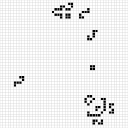Rx202
Jump to navigation
Jump to search
| Rx202 | |||||||||
| View static image | |||||||||
| Pattern type | Conduit | ||||||||
|---|---|---|---|---|---|---|---|---|---|
| Conduit type | Composite | ||||||||
| Input | Herschel | ||||||||
| Number of cells | 97 | ||||||||
| Bounding box | 31 × 47 | ||||||||
| Output orientation | Turned right, flipped | ||||||||
| Output offset | (7, 32) | ||||||||
| Step | 202 ticks | ||||||||
| Recovery time (ignoring FNG if any) |
201 ticks | ||||||||
| Minimum overclock period (ignoring FNG if any) |
Unknown | ||||||||
| Spartan? | No | ||||||||
| Dependent? | No | ||||||||
| Discovered by | David Buckingham | ||||||||
| Year of discovery | 1997 | ||||||||
| |||||||||
| |||||||||
- Not to be confused with Rx262.
Rx202 is a composite conduit, one of the original sixteen Herschel conduits, discovered by Dave Buckingham in May 1997. It is made up of two elementary conduits, HR143B and BFx59H. After 202 ticks, it produces an inverted Herschel turned 90 degrees clockwise at (7, 32) relative to the input. Its recovery time is 201 ticks.
The eater 1 welded onto the eater 3 can be removed if the following conduit is dependent, but the eater 3 then must be stabilised with snakes near the outer edge. An eater 5 or sidesnagger can be used instead of the welded eater 1.
In the pattern shown in the infobox, a ghost Herschel marks the output location.
Gallery
 HR143B |
+ |  BFx59H |
| The two elementary conduits that form Rx202 | ||
External links
- Rx202 at the Life Lexicon
Categories:
- Patterns
- Patterns with 97 cells
- Patterns found by David Buckingham
- Patterns found in 1997
- Outer-totalistically endemic patterns
- Conduits
- Composite conduits
- Herschel conduits
- Conduits with output orientation Rx
- Conduits with output offset (7, 32)
- Conduits with recovery time 201
- Non-Spartan conduits
- Independent conduits